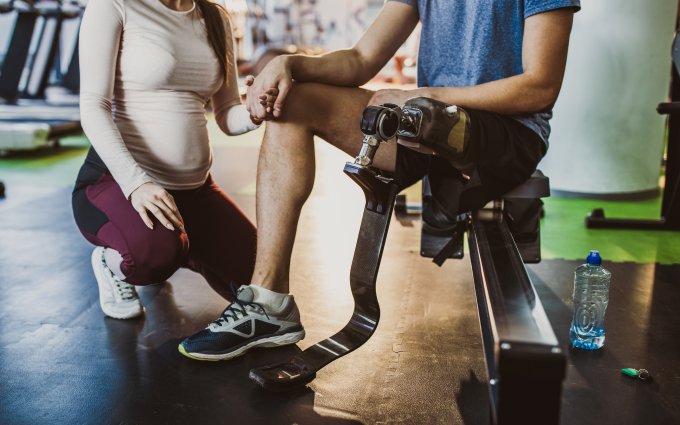01/26/2016

In the United States, almost two million people have experienced limb loss, and every day more than 500 Americans lose an upper or lower extremity. Of those with limb loss, 45% can be attributed to trauma.
Paradigm recently hosted a webinar, the conclusion of a two-part series, titled Multidisciplinary Care of Amputations: Lower Limb Focus (Part 2). A physician specializing in amputations and multiple trauma cases provided the knowledge to successfully manage the care of complex lower limb amputations, including recognizing the classification levels, clinical approaches and pre- and post-op considerations. Gary Clark, M.D., director of amputee rehabilitation at the MetroHealth Rehabilitation Institute in Cleveland, Ohio, identified the functional potential, complications and various prosthetic options, which are all vital to providing the best care for injured workers who have suffered limb loss. We published a recap of the upper limb webinar in December. You can view replays of part one and part two of the webinar series online.
Considerations for Therapeutic Amputation
Dr. Clark first presented on limb trauma surgery and what is feasible versus advisable. While there is an unknown outcome and timeframe with limb salvage and reconstruction, conversely there is a predictable outcome and timeframe with therapeutic amputation. With amputation surgery, some of the most significant goals are to preserve the functional length, useful sensation and symptomatic neuromas, maintain durable skin/soft tissue coverage and viable circulation, and facilitate early prosthetic fitting and patient return to work. In the end, it is always preferable to perform an elective amputation in the face of non-healing, after multiple salvage attempts and to avoid urgent amputation due to progressive infection because of increased risks and even death.
There are various levels of amputation, including partial foot, ankle/knee/hip disarticulation, transtibial, and transfemoral. The most common level of amputation is toe disarticulation. The metabolic cost of walking with an amputation is significant depending on the level. Transfemoral, or above the knee amputation, has the greatest metabolic cost, as the patient must control two joints—the knee and the ankle.
Prostheses and Rehabilitation
When prescribing a prosthesis, the provider must consider many factors, such as the amputation level, length of the residual limb, skin/soft tissue mass, cognitive function, functional goals and cosmetic importance. A successful prosthesis is comfortable, easy to don and doff, lightweight yet durable, cosmetically pleasing, easy to maintain and customizable. There are various Medicare amputee functional levels, which range from K0 (non-ambulator) to K4 (active adult or athlete). There are also numerous components and options when prescribing a prosthesis. The cost of a prosthetic foot tends to range between $1,200 and $70,000, and the cost of a prosthetic knee can be from $1,000 to $115,000. This is all dependent on the category, K-Level, control mechanism and goal of the patient.
The clinical team, involving the surgeon, physiatrist, occupational therapist, prosthetist, psychologist, patient and her family, must carefully coordinate an amputee’s rehabilitation. The care plan should include an initial evaluation, including education, realistic goal setting and a prosthetic prescription, and frequent follow-up appointments where the fit and function of the prosthesis are evaluated. Long-term follow-up should include prosthetic modifications, maintenance and vocational needs.
Typical outpatient physical therapy for a lower limb prosthetic involves many areas of training. This includes using a shrinker sock, proper donning and doffing technique, gait training, strengthening and conditioning, energy conservation, cleaning and learning to “listen to your body,” just to name a few.
Risks and Goals of Lower Limb Amputation
Similar to upper limb amputations, there are many possible complications for lower extremity amputations. These include skin, pain and neurological issues, as well as prosthetic failure. Psychological issues must equally be recognized and addressed. Patients often experience extreme feelings, such as mourning the loss of their limb, depression, body disfigurement and adjustment to having a disability. For the injured worker to successfully return to work, providers must consider what his premorbid career was, level of employer support and flexibility, functional independence with the prosthesis, successful adaptation to the disability, and job coaching and training.
In summary, the goal for the patient must absolutely be realistic. There must be appropriate training and fit of the prosthetic, injured worker adherence to prescription recommendations, and awareness that new technology is not always superior because it is constantly evolving and usually much heavier and more expensive.
For a more detailed review of lower limb amputations, listen to a replay of our December webinar, Multidisciplinary Care of Amputations: Lower Limb Focus (Part 2). Stay tuned for additional interesting topics covered in our 2016 webinar series.